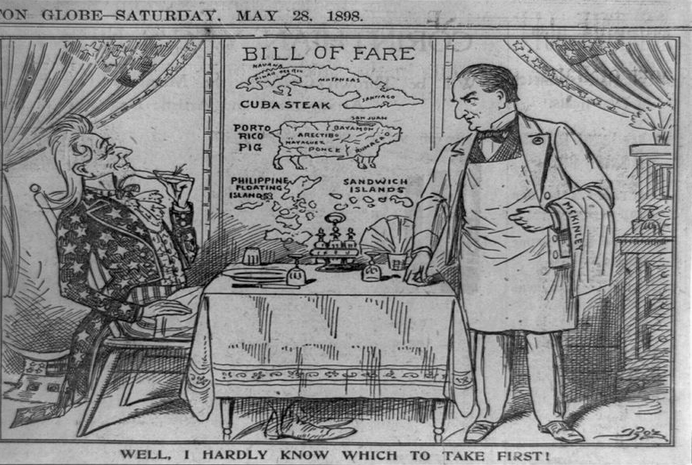
A lesson plan from Dr. Gayle Olson-Raymer, “Manifest Destiny Moves into the Pacific †@ gohistory
[S]everal individuals had set their sights on the strategically located Hawaiian Islands (then called the Sandwich Islands). Manifest Destiny initially came to Hawaii not at the request of the United States government, but rather at the hands of private business entrepreneurs and missionaries. In the late 1820s, the first Americans began to settle in Hawaii when Presbyterian and Congregational missionaries founded schools to Christianize and Americanize the Hawaiians.
Within two decades of missionary work, the Hawaiian monarchy was worried about increasing American influence on the islands. Thus, three laws were passed that determined who could own land in Hawaii.
- The 1840 Constitution of the Kingdom of Hawaii proclaimed that the land belonged to its people and was to be managed by the King. King Kamehameha and his 245 chiefs allocated one-third of the land to the Hawaiian crown, one-third to the chiefs, and one-third to the people.
- The 1850 Alien Land Ownership Act was passed by the Hawaiian legislature in opposition to the King. The Act, which allowed foreigners to hold title to land, was supported as a way to bring much-needed capital and labor to the islands.
- The 1850 Kuleana Act allowed Hawaiian commoners to petition for title to land on which they already cultivated and/or lived. Because private ownership of land was a previously unknown concept for ordinary Hawaiians, many did not understand the need to make a claim for land on which they already lived or worked.
- Making a claim depended on the ability to read, to pay for a pre-claim land survey, and to find two witnesses to confirm that the claimant had worked the land.
- The law also stated that the lands must be claimed within two years of the Act’s passage.
By the late 1850s, few Hawaiians had made claims. Eventually, less than one percent of the land was ever owned by the people. Instead, the chiefs and foreigners owned and controlled almost all the land while the Hawaiian people collectively worked the land.
Sugar plantations, some owned by Americans, began to grow in Hawaii.
- By the 1840s, the profits of plantation owners rose and fell according to American tariffs placed on imported sugar.
- During the Civil War when Southern sugar could not be shipped up north, Hawaiian planters’ profits soared as the price of sugar rose 525% – from 4 cents per pound in 1861 to 25 cents in 1864.
- Profits again skyrocketed with the Reciprocity Treaty of 1875 which allowed Hawaii to sell sugar to the United States without paying duties or taxes. The Treaty led to large American investments in Hawaiian sugar plantations.
- By 1885, almost all Hawaiian sugar plantations were owned by Americans, most of whom were the ancestors of the early missionaries. Not surprisingly, the planters began to demand a greater role in Hawaiian politics.
HAWAII’S DISCORDANT ‘PARADISE’
Monday, May 17, 2021 Nancy San Martin, Deputy Managing Editor, HISTORY and CULTURE

Before the United States took over Hawaii, it was ruled by a monarchy. And its last queen, Lili’uokalani, was forced to renounce her throne after a cabal of sugar plantation owners plotted a coup that overthrew her government. “With her signature on January 24, 1895, generations of a Hawaiian monarchy came to an end,†writes Erin Blakemore for Nat Geo. “The islands Liliʻuokalani once ruled would soon be annexed by the United States at the behest of white settlers who had come to see Hawaii as a cash cow. The legacy of that loss to a wealthy minority still resonates today.
Hawaii became a U.S. territory in 1898, a status that lasted until 1959 when it became the 50th American state. About 10 percent of the islanders today are of Native Hawaiian descent. The largest proportion of residents are of Asian descent, followed by white and multiethnic backgrounds.
One of the more shameful things in the history of the United Church of Christ and its predecessor denominations is its participation in the overthrow of the Hawai’ian monarchy and its subsequent annexation by the United States.
PUBLIC LAW 103-150—NOV. 23, 1993 states in part, †Whereas the Congregational Church (now known as the United Church of Christ), through its American Board of Commissioners for Foreign Missions, sponsored and sent more than 100 missionaries to the Kingdom of Hawaii between 1820 and 1850; Whereas, on January 14, 1893, John L. Stevens (hereafter referred to in this Resolution as the “United States Ministerâ€), the United States Minister assigned to the sovereign and independent Kingdom of Hawaii conspired with a small group of non-Hawaiian residents of the Kingdom of Hawaii, including citizens of the United States, to overthrow the indigenous and lawful Government of Hawaii; Whereas, in pursuance of the conspiracy to overthrow the Government of Hawaii, the United States Minister and the naval representatives of the United States caused armed naval forces of the United States to invade the sovereign Hawaiian nation on January 16, 1893, and to position themselves near the Hawaiian Government buildings and the lolani Palace to intimidate Queen Liliuokalani and her Government; Whereas, on the afternoon of January 17, 1893, a Committee of Safety that represented the American and European sugar planters, descendents of missionaries, and financiers deposed the Hawaiian monarchy and proclaimed the establishment of a Provisional Government;
Read HERE for the entire Joint Resolution and HERE for more information.